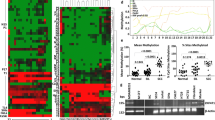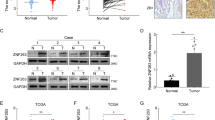Abstract
Zinc-finger proteins are involved in many biological processes. However, the role of Zinc-finger protein 334 (ZNF334) in cervical cancer remains unidentified. This study showed that promoter methylation of ZNF334 was responsible for its reduced expression. ZNF334 suppressed malignant biological behaviors in cervical cancer. Notably, ZNF334 reversed the EMT process both in vitro and in vivo. RNA-seq coupled with bioinformatics analysis caught P3H3 which is upregulated by ZNF334. Dual-luciferase reporter and Chromatin immunoprecipitation assays illustrated that ZNF334 directly regulate P3H3. Knockdown of P3H3 attenuated the reversal of EMT induced by ZNF334. Additionally, ZNF334 overexpression sensitized cervical cancer cells to the cytotoxic effects of paclitaxel, cyclosporine and sunitinib. In conclusions, this study illustrated that DNA methylation-based silencing ZNF334 played a vital role in cervical cancer, by regulating P3H3 in turn affects EMT. ZNF334 has the potential to become a novel diagnostic biomarker and a potential treatment target for cervical cancer.
Graphical abstract







Similar content being viewed by others
Data availability
Online analysis was performed using UALCAN (http://ualcan.path.uab.edu), CTD (https://ctdbase.org), STRING (https://cn.string-db.org) and Gepia2 (http://gepia2.cancer-pku.cn) with TCGA database. Part of data that support the findings of this study are not openly available due to reasons of sensitivity and are available from the corresponding author upon reasonable request.
References
Siegel RL, Miller KD, Wagle NS, et al. Cancer statistics, 2023. CA Cancer J Clin. 2023;73(1):17–48.
Perkins RB, Wentzensen N, Guido RS, et al. Cervical cancer screening: a review. JAMA. 2023;330(6):547–58.
Zhu B, Liu Q, Han Q, et al. Downregulation of Krüppel-like factor 1 inhibits the metastasis and invasion of cervical cancer cells. Mol Med Rep. 2018;18(4):3932–40.
Chan DW, Yu SY, Chiu PM, et al. Over-expression of FOXM1 transcription factor is associated with cervical cancer progression and pathogenesis. J Pathol. 2008;215(3):245–52.
Zhang Z, Peng J, Li B, et al. HOXA1 promotes aerobic glycolysis and cancer progression in cervical cancer. Cell Signal. 2023;109: 110747.
Huang H, Han Q, Zheng H, et al. MAP4K4 mediates the SOX6-induced autophagy and reduces the chemosensitivity of cervical cancer. Cell Death Dis. 2021;13(1):13.
Li L, Gong Y, Xu K, et al. ZBTB28 induces autophagy by regulation of FIP200 and Bcl-XL facilitating cervical cancer cell apoptosis. J Exp Clin Cancer Res. 2021;40(1):150.
Ni M, Li J, Zhao H, et al. BRD4 inhibition sensitizes cervical cancer to radiotherapy by attenuating DNA repair. Oncogene. 2021;40(15):2711–24.
Yang WT, Zheng PS. Krüppel-like factor 4 functions as a tumor suppressor in cervical carcinoma. Cancer. 2012;118(15):3691–702.
Cheng Z, Yu R, Li L, et al. Disruption of ZNF334 promotes triple-negative breast carcinoma malignancy through the SFRP1/ Wnt/β-catenin signaling axis. Cell Mol Life Sci. 2022;79(5):280.
Yang B, Tang H, Wang N, et al. Targeted DNA demethylation of the ZNF334 promoter inhibits colorectal cancer growth. Cell Death Dis. 2023;14(3):210.
Gerstberger S, Jiang Q, Ganesh K. Metastasis. Cell. 2023;186(8):1564–79.
Bakir B, Chiarella AM, Pitarresi JR, et al. EMT, MET, plasticity, and tumor metastasis. Trends Cell Biol. 2020;30(10):764–76.
Aiello NM, Maddipati R, Norgard RJ, et al. EMT subtype influences epithelial plasticity and mode of cell migration. Dev Cell. 2018;45(6):681-95.e4.
Prakash V, Carson BB, Feenstra JM, et al. Ribosome biogenesis during cell cycle arrest fuels EMT in development and disease. Nat Commun. 2019;10(1):2110.
Hudson DM, Weis M, Rai J, et al. P3h3-null and Sc65-null mice phenocopy the collagen lysine under-hydroxylation and cross-linking abnormality of ehlers-danlos syndrome type VIA. J Biol Chem. 2017;292(9):3877–87.
Pokidysheva E, Boudko S, Vranka J, et al. Biological role of prolyl 3-hydroxylation in type IV collagen. Proc Natl Acad Sci U S A. 2014;111(1):161–6.
Singh D, Vignat J, Lorenzoni V, et al. Global estimates of incidence and mortality of cervical cancer in 2020: a baseline analysis of the WHO Global cervical cancer elimination initiative. Lancet Glob Health. 2023;11(2):e197–206.
Cohen PA, Jhingran A, Oaknin A, et al. Cervical cancer. Lancet. 2019;393(10167):169–82.
Jeannot E, Latouche A, Bonneau C, et al. Circulating HPV DNA as a marker for early detection of relapse in patients with cervical cancer. Clin Cancer Res. 2021;27(21):5869–77.
Qiu J, Qu X, Wang Y, et al. Single-cell landscape highlights heterogenous microenvironment, novel immune reaction patterns, potential biomarkers and unique therapeutic strategies of cervical squamous carcinoma, human papillomavirus-associated (HPVA) and non-HPVA adenocarcinoma. Adv Sci (Weinh). 2023;10(10):e2204951.
van den Helder R, Steenbergen RDM, van Splunter AP, et al. HPV and DNA methylation testing in urine for cervical intraepithelial neoplasia and cervical cancer detection. Clin Cancer Res. 2022;28(10):2061–8.
Chaffer CL, Weinberg RA. A perspective on cancer cell metastasis. Science. 2011;331(6024):1559–64.
Fares J, Fares MY, Khachfe HH, et al. Molecular principles of metastasis: a hallmark of cancer revisited. Signal Transduct Target Ther. 2020;5(1):28.
Yuan Z, Li Y, Zhang S, et al. Extracellular matrix remodeling in tumor progression and immune escape: from mechanisms to treatments. Mol Cancer. 2023;22(1):48.
Winkler J, Abisoye-Ogunniyan A, Metcalf KJ, et al. Concepts of extracellular matrix remodelling in tumour progression and metastasis. Nat Commun. 2020;11(1):5120.
Su H, Karin M. Multifaceted collagen-DDR1 signaling in cancer. Trends Cell Biol. 2023. https://doi.org/10.1016/j.tcb.2023.08.003.
Armstrong T, Packham G, Murphy LB, et al. Type I collagen promotes the malignant phenotype of pancreatic ductal adenocarcinoma. Clin Cancer Res. 2004;10(21):7427–37.
Chen Y, Yang S, Tavormina J, et al. Oncogenic collagen I homotrimers from cancer cells bind to α3β1 integrin and impact tumor microbiome and immunity to promote pancreatic cancer. Cancer Cell. 2022;40(8):818-34.e9.
Cheon DJ, Tong Y, Sim MS, et al. A collagen-remodeling gene signature regulated by TGF-β signaling is associated with metastasis and poor survival in serous ovarian cancer. Clin Cancer Res. 2014;20(3):711–23.
Ishikawa Y, Taga Y, Zientek K, et al. Type I and type V procollagen triple helix uses different subsets of the molecular ensemble for lysine posttranslational modifications in the rER. J Biol Chem. 2021;296: 100453.
Shah R, Smith P, Purdie C, et al. The prolyl 3-hydroxylases P3H2 and P3H3 are novel targets for epigenetic silencing in breast cancer. Br J Cancer. 2009;100(10):1687–96.
Rømer AMA, Thorseth ML, Madsen DH. Immune modulatory properties of collagen in cancer. Front Immunol. 2021;12:791453.
Su H, Karin M. Collagen architecture and signaling orchestrate cancer development. Trends Cancer. 2023;9(9):764–73.
Austin DF. Smoking and cervical cancer. JAMA. 1983;250(4):516–7.
Brinton LA, Schairer C, Haenszel W, et al. Cigarette smoking and invasive cervical cancer. JAMA. 1986;255(23):3265–9.
Wen Q, Wang X, Lv J, et al. Association between involuntary smoking and risk of cervical cancer in Chinese female never smokers: A prospective cohort study. Environ Res. 2022;212(Pt C): 113371.
Kim JY, Lee DW, Kim MJ, et al. Secondhand smoke exposure, diabetes, and high BMI are risk factors for uterine cervical cancer: a cross-sectional study from the Korea national health and nutrition examination survey (2010–2018). BMC Cancer. 2021;21(1):880.
Wu PJ, Hsin IL, Hung WL, et al. Combination treatment with cyclosporin A and arsenic trioxide induce synergistic cell death via non-apoptotic pathway in uterine cervical cancer cells. Chem Biol Interact. 2022;368: 110177.
Andersson Y, Engebraaten O, Fodstad Ø. Synergistic anti-cancer effects of immunotoxin and cyclosporin in vitro and in vivo. Br J Cancer. 2009;101(8):1307–15.
Teranishi R, Takahashi T, Obata Y, et al. Combination of pimitespib (TAS-116) with sunitinib is an effective therapy for imatinib-resistant gastrointestinal stromal tumors. Int J Cancer. 2023;152(12):2580–93.
Proto C, Manglaviti S, Lo Russo G, et al. STYLE (NCT03449173): a phase 2 trial of sunitinib in patients with type B3 thymoma or thymic carcinoma in second and further lines. J Thorac Oncol. 2023;18(8):1070–81.
Network NCC. NCCN Clinical Practice Guidelines in Oncology. Cervical Cancer (Version 1.2023)[J]. 2023.
Bardou P, Mariette J, Escudié F, et al. jvenn: an interactive Venn diagram viewer. BMC Bioinformatics. 2014;15(1):293.
Chandrashekar DS, Bashel B, Balasubramanya SAH, et al. UALCAN: a portal for facilitating tumor subgroup gene expression and survival analyses. Neoplasia. 2017;19(8):649–58.
Tang Z, Li C, Kang B, et al. GEPIA: a web server for cancer and normal gene expression profiling and interactive analyses. Nucleic Acids Res. 2017;45(W1):W98-w102.
Li Y, Ge D, Lu C. The SMART App: an interactive web application for comprehensive DNA methylation analysis and visualization. Epigenetics Chromatin. 2019;12(1):71.
Davis AP, Wiegers TC, Johnson RJ, et al. Comparative toxicogenomics database (CTD): update 2023. Nucleic Acids Res. 2023;51(D1):D1257–62.
Acknowledgements
Not applicable.
Funding
This study was supported by National Natural Science Foundation of China (#82172619), Natural Science Foundation of Chongqing (CSTC2021jscx-gksb-N0023, CSTB2022NSCQ-M SX0063, CSTB2023NSCQ-MSX0386) and Medical and Industrial Integration Project (2022CDJYGRH-002).
Author information
Authors and Affiliations
Contributions
TX, JT: conception and design. QL, XZ: performed majority of experiments. YG, BS, JW, LZ, QX: performed experiments and analyzed data. YW, JT: collected samples. QL: drafted the manuscript. JX, XG: reviewed data and manuscript. TX, QL,JT: reviewed data and finalized the manuscript. All authors reviewed and approved the final version.
Corresponding authors
Ethics declarations
Competing interests
The authors declare no competing interests.
Competing interest
The authors declare no competing interests.
Institutional Review Board
Clinical samples used were subjected to histological diagnosis by pathologists, and informed consent was obtained from patients for the acquisition of tissue specimens. The Ethics Committee of Chongqing University Cancer Hospital approved of this study (approval notice: CZLS2022030-A). All animal experiment finished in Laboratory Animal Center of Chongqing University Cancer Hospital (CQCH-LAE-A0000202010).
Informed consent
Informed consent was obtained from all subjects involved in the study.
Additional information
Publisher's Note
Springer Nature remains neutral with regard to jurisdictional claims in published maps and institutional affiliations.
Supplementary Information
Below is the link to the electronic supplementary material.
Rights and permissions
Springer Nature or its licensor (e.g. a society or other partner) holds exclusive rights to this article under a publishing agreement with the author(s) or other rightsholder(s); author self-archiving of the accepted manuscript version of this article is solely governed by the terms of such publishing agreement and applicable law.
About this article
Cite this article
Li, Q., Zhou, X., Xiao, J. et al. Role of ZNF334 in cervical cancer: implications for EMT reversal and tumor suppression. Med Oncol 41, 191 (2024). https://doi.org/10.1007/s12032-024-02433-2
Received:
Accepted:
Published:
DOI: https://doi.org/10.1007/s12032-024-02433-2




